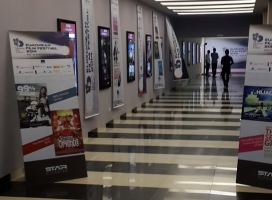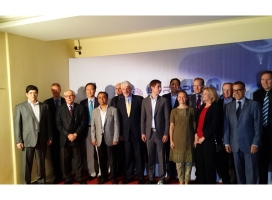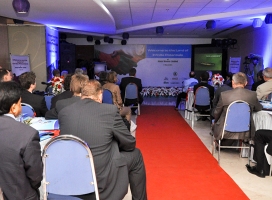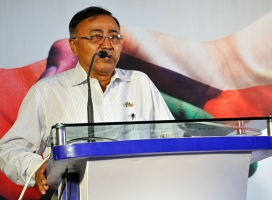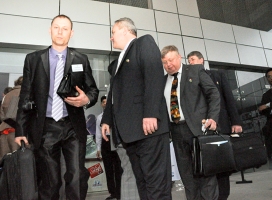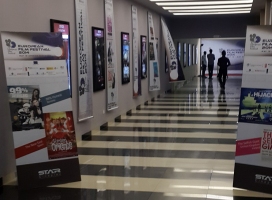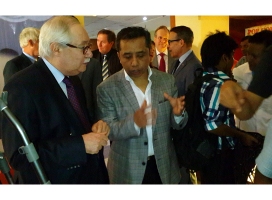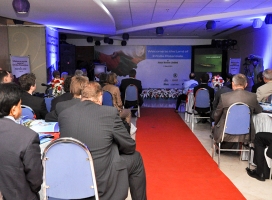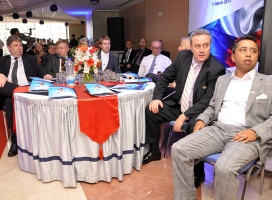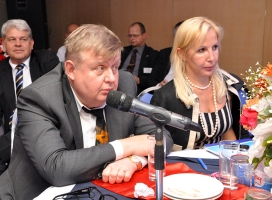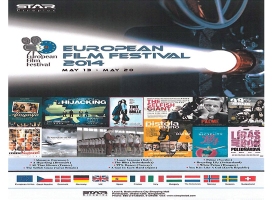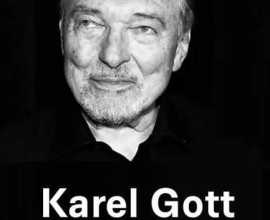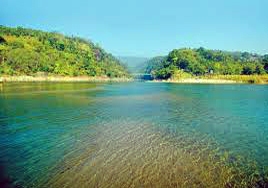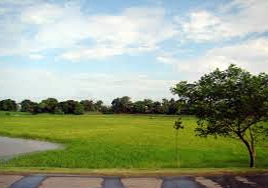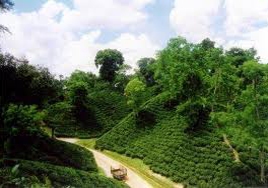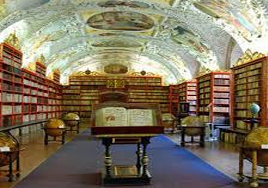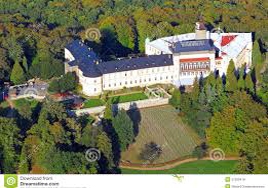All Gallery
Journal/Newsletter
| Newsletter | |||||
|---|---|---|---|---|---|
| No | View the Newsletter | Download the Newsletter | |||
| 1 | Synopsis-March 03, 2020 | Synopsis-March 03, 2020 | |||
Press Release
The golden voice from Prague passed away
Famous Czech singer Karel Gott died on October 2nd, 2019 at the age of 80. Flags are being flown at half-mast in the Czech Republic and also at its Embassies across the world on October 12th, 2019 and public events have been toned down as Czechs observe a day of mourning for their national idol and pop star Karel Gott. The same day, the singer has been given a funeral with state honours, including a funeral mass at St. Vitus Cathedral in Prague.
———————————————————————————————————————————————————————–
A.S.M. Mohiuddin Monem appointed the Honorary Consul of the Czech Republic in Bangladesh
Mr. A.S.M. Mohiuddin Monem has been appointed the Honorary Consul of the Czech Republic recently, says a press release.
Mr. ASM Mohiuddin Monem is the capable son of gifted business legend Mr. Abdul Monem. Mr. Mohiuddin Monem, is the Deputy Managing Director of Abdul Monem Limited, a leading business conglomerate of Bangladesh, Chairman of ServicEngine Limited, among the top 100 Business Process Outsourcing companies in the world as recognized by Fortune, the global business magazine; Director of Pragati Insurance Limited and Pragati Life Insurance Limited as well as a former Director DCCI (Dhaka Chamber of Commerce & Industry). He is also a CIP (Commercially Important Person) in Bangladesh consecutively for the past few years. He will serve five years in this capacity.
He received his Bachelor’s Degree in Industrial Engineering from North Eastern University, Boston, U.S.A. in 1991 and a Master’s Degree in Engineering Management from the same institution in 1994, where he graduated with honors with CUM LAUDE. He is associated with philanthropic and corporate social responsibility causes through Abdul Monem Foundation striving to contribute in social development.
Mr. Monem, in his new role, responsibility and stature hopes to bring the people of both the Czech Republic and Bangladesh closer through bilateral trade, commerce ; exchange of culture, heritage and build stronger ties through the promotion of relevant issues between both the friendly nations.
Mr. Monem stated, “This is a great responsibility bestowed upon me to build strong bilateral relations and business ties between the Czech Republic and Bangladesh as well as create a feeling of warmth between the people of both countries. It is also a fabulous opportunity for me to positively project Bangladesh as a friendly nation with healthy business environment, ultimately contributing to the image building of our country”.
Tourism in Bangladesh
Bangladesh, also known as The Republic of Bangladesh, is located in South Asia. This country shares a border with India on all sides, leaving a small portion, which it shares with Myanmar. The main rivers flowing through this country are the Ganges and Padma, Brahmaputra and Meghna. Bangladesh is known around the world because of its wetlands, dense forests, mangroves and other recognized places. Here you can find great variety of flora and fauna. Royal Bengal tigers, which are largely those in this country.
Climate : The weather in Bangladesh is very nice and makes it a favorable destination for tourists from around the world. Bangladesh is at sea level of the Ganges and the Brahmaputra and the Ganges River delta. This delta is formed by the convergence of the Ganges, Brahmaputra and Meghna rivers and their tributaries. The largest selection of Bangladesh is in Mowdok that rises 1.052 meters high in the hills of Chittagong in the southeast and throughout the country. The weather in Bangladesh is tropical season. On both sides of the Tropic of Cancer, The weather in Bangladesh is tropical with a mild winter from October to March. Still hot with humidity increases during the summer from March to June. A warm and humid monsoon season runs from June to October and provides most of the rainfall in the country. Bangladesh is a hot, humid in summer and cold in winter. During the monsoon season, heavy rains occur in Bangladesh, and sometimes a major flood. Comes mainly from rainfall during the monsoon season which covers the months of June to September, and low in winter months from November to February. The weather in Bangladesh is characterized by reasonably high temperature during eight months of the year with maximum temperature in summer ranges from 30 ° C to 38 ° C, whereas the minimum temperature is 9 ° C during winter. Due to the variation in Bangladesh of time, travelers can take some light cottons and linens throughout the year. Requires warmer clothing at night in cold season.
Destinations : Bangladesh is one of the most visited tourist destinations in the world. If you are looking for an exotic place and plan a trip to Bangladesh. The unique aspects of the variety of tourist destinations in Bangladesh is to delight the most discerning travelers. As your holiday to explore the various tourist destinations in Bangladesh in the best possible way.
Dhaka : Dhaka, has great natural treasures. The architectural beauty and natural wonders of the capital city of Bangladesh, has attracted tourists for decades. These are the many attractions of the city. These include mosques, Hindu temples. Dhakeshwari, the Armenian Church, the Cathedral of St. Mary in Ramna, and the Holy Rosary Church Teigaon, the Lalbagh Fort, the 1857 Memorial and National Memorial. The visitors also love to see the cultural and architectural displays in museums. Explore the resorts and explore the city and its surrounding parts. Do not forget to buy some of the beautiful crafts that are sold in traditional markets of the city.
Chittagong : The second largest city is known for its picturesque landscape. The charm and excitement of the city winning the hearts of many travelers. The obvious beauty of the city, caters to the tastes of different types of travelers. The attractions are the tomb of Sultan Bayazid Bostami Cemetery of the Second World War Shrine of Shah Amanat, The Museum and the Merchant Marine Academy Juldia.
Cox’s Bazar : One of the important tourist destinations in Bangladesh is Cox’s Bazar. Cox Bazar is famous among tourists for being the longest unbroken beach in the world tracks. The soft golden sand beaches, majestic cliffs, the green vegetation, colorful pagodas and shrines of Cox Bazar, make it an idyllic holiday destination.
Khulna : Sundarbans, the largest mangrove forests in the world is in the region of Bangladesh, Khulna. There are many attractive places in this city of Bangladesh.
Patuakhali : Kuakata, locally known as Sagar Kannya (Daughter of the Sea) is a rare scenic beauty spot on the southernmost tip of Bangladesh. Kuakata in Latachapli union under Kalapara Police Station of Patuakhali district is about 30 km in length and 6 km in breadth. It is 70 km from Patuakhali district headquarters and 320 km from Dhaka. At Kuakata excellent combination of the picturesque natural beauty, sandy beach, blue sky, huge expanse of water of the Bay and evergreen forest in really eye-catching.
Sylhet : Sylhet is known for its exotic beauty. The flora and fauna, tea plantations, tropical forests. The attractions are Madhabkunda, Tamabil-Jaflong and the shrine of Hazrat Shah Jalal.
Rajshahi : Rajshahi, located on the river Padma is one of the most favored tourist places in Bangladesh. Visitors can see the different mosques, shrines, temples.
Tourism in Czech Republic
Basic information are available at www.czechtourism.com
Thanks to its location at the crossroads of various cultures in the heart of Europe, the Czech Republic has countless cultural and historical points of interest. The Czech Republic is a country of great historical and cultural importance, a country where historic monuments and entire towns have been included on the World Heritage List. Of course, when discussing tourism in Czech Republic, one can not overlook the overhelmingly popular tourist destination of Prague. The city is generaly considered to be one of the most beautiful world capitals with an exquitely preserved historical center. Many other towns and historic monuments in the Czech Republic are well-preserved and are noted in the UNESCO register as world cultural landmarks. Some of the towns are also known as glowing assets of the Czech Republic due to the existence of curative mineral spring spas there. Spas like Karlovy Vary (Karlsbad) and Marianske Lazne (Marienbad) acquired their international eminence many years ago. Jachymov, another town in the countryside, is well known for its rare radioactive springs. Terezin is also often explored by tourists. Terezin was a fort town from the end of the 18th century which, during the war, was transformed into a Jewish ghetto by the Nazis.
Prague
In 1992 the historical centre of Prague covering an area of 866 hectares was listed in the UNESCO World Cultural and Natural Heritage Register. Prague has always played an important role in the history of the nation, the country and the whole of Europe. She has cherished the reputation of one of the most beautiful cities in the world and has been paid tribute by outstanding personalities.
Selected Distances:
| – Berlin | 282 km | – Moscow | 1,665 km | |
| Prague | – Paris | 864 km | – Warsaw | 512 km |
| – London | 1,030 km | – Budapest | 457 km | |
| – New York | 6,561 km | – Istanbul | 1,504 km |
THE UNESCO REGISTER OF THE WORLD HERITAGE MONUMENTS
The World Heritage Committee has inscribed the following properties on the World Heritage List.
1992 Historic Centre of Prague
1992 Historic Centre of Cesky Krumlov
1994 Pilgrimage Church of St. John of Nepomuk at Zelena Hora
1996 Lednice-Valtice Cultural Landscape
1998 Holasovice Historical Village Reservation
1998 Gardens and Castle at Kromeríz
1999 Litomyšl Castle
2000 Olomouc – the Column of the Holy Trinity
PRINCIPAL MOUNTAIN RANGES
Krkonoše (Giant Mountains )
The Krkonoše range stretches 40km into Bohemian territory, creating a natural border between the Czech Republic and Poland, and is the Czech Republic´s highest mountain range. The highest peak is Mt. Snezka (1,602 m). Several other peaks exceed 1,500 m. In order to preserve both wildlife and the environment, the Krkonoše was proclaimed a national park in 1963
Hruby Jeseník (Ash Mountains)
The Hrubý Jeseník is the second highest mountain range in the Czech Republic, and its highest point is Praded Peak (1,491 m). Located in northern Moravia, this range is similar in character to the Krkonoše and has been a protected region since 1969.
Sumava (Bohemian Forest)
The third highest mountain range in the Czech Republic, the Šumava´s highest point is Plechý Peak (1,373 m). The Šumava extends 125 km into south-western Bohemia from the border and creates a natural boundary with Germany. Five limestone lakes found here are of glacial origin. The Black Lake is the largest (18.61 hectares). The Šumava has been a protected region since 1962 and was declared a national park in 1991. This region is also protected on the German side where it becomes The Bavarian Forest National Park.
Beskydy The Morava-Silesian Beskydy Mountains are situated in the eastern part of the Czech Republic in northern Moravia. The area shares borders with Poland to the north and with the Slovak Republic to the east. The Beskydy Mountains are part of a frontier mountain range that runs from north to south, with the highest points over 1000 m above sea level. Its landscape of long, rolling hillsides is covered with forests and pastures. The terrain is ideal for hiking, cross-country skiing and mountain biking.
LAKES AND RIVERS
The Czech Republic is called the roof of Europe since its only source of water is atmospheric rain and snowfall. All the rivers which have their source in the area drain into neighboring countries
The Czech Republic has three river basins:
The Labe (Elbe) River Basin (drains into the North Sea) – 51,399 sq.km. Main rivers: Labe, Vltava
The Odra (Oder) River Basin (drains into the Baltic) – 4,721 sq.km. Main rivers: Odra, Opava, Ostravice and Olše
The Dunaj (Danube) River Basin (drains into the Black Sea) – 22,744 sq. km. Main rivers: Morava, Dyje
The river basins intersect at Kralický Sni3ník on the Polish border.
Lakes and ponds
There are 455 natural lakes in the Czech Republic, 350 of which are river lakes that have formed in the grasslands of larger rivers. A characteristic feature of the Czech landscape is the large number of artificial lakes created for fish-farming. They number 21,800 in total and cover about 41,000 hectares. The largest of them are Lake Rozmberk and Lake Bezdrev in southern Bohemia.
MINERAL WATERS and SPAS
The abundance and quality of mineral springs in the Czech Republic makes the country a world leader in this area. Many large and renowned spas have been founded around natural or drilled mineral water springs, including the spa in Karlovy Vary, as well as in Mariánské Lázne, Františkovy Lázne, Podebrady, Luhacovice, Jáchymov, and many others which are smaller but still therapeutically important. The warmest Czech springs include the famous Thermal Spring in Karlovy Vary (72oC), and springs in Teplice (42oC) and Janské Lázni (29.6oC). The waters from former uranium mines in Jáchymov have the highest radioactivity in the world (5,085 Mach units, .08 oz.Rn/gal.)
Karlovy Vary
Karlovy Vary are the best known and biggest spa in the Czech Republic. It is world famous for its hot mineral springs and mineral salts. The place has very long history and today it is presumably the second most visited town in the Czech Republic after Prague.The healing sources are rare hydrocarbonate-sulfur-chloride and hydrocarbonate-sodium-calcium thermal mineral waters.World famous liqueur Becherovka is also produced in Karlovy Vary.
Marianske Lazne
The second most important spa in the Czech Republic about which a written record is already from the year 1528 are situated in West Bohemia near town Cheb. Many famous writers, composers, poets and phylosofers spend their time in this picturesque town and enjoyed the forrests and hills around.
Lazne Luhacovice
Luhacovice is the biggest spa in Moravia with the tradition of more than 300 years of spa treatment, based on the curative power of the natural mineral springs.Thanks to the long-standing tradition of the spa treatment, mineral springs, favorable climate conditions and a beautiful natural surrounding.
Trade & Commerce in Bangladesh
Bangladesh is a developing nation. Goldman Sachs named it one of the “Next Eleven”. Bangladesh gradually decreased its dependency on foreign grant and loan from 85% (In 1988) to 2% (In 2010) for its annual development budget. Its per capita income in 2010 was US$641 compared to the world average of $8,985. In December 2005, the Central Bank of Bangladesh projected GDP growth around 6.5%.
Bangladesh has seen a dramatic increase in foreign direct investment. In order to enhance economic growth, the government set up several export processing zones to attract foreign investment The Bangladesh Export Processing Zone Authority manages these.
Bangladesh government is planning for construction of the largest deep-sea port in South Asia at Sonadia Island. The 500 billion Taka project will be completed in multiple phases and enable Bangladesh to service the whole region as a maritime transport and logistics hub. India, China, Bhutan, Nepal and other neighbouring countries will be able to take full advantage of the strategic location and Bangladesh’s LDC status for exporting their goods, which are manufactured in Bangladesh.
Today Bangladesh is the second biggest producer of textiles’ and soon will overtake the current leader China. It is not just the textile industry, which is flourishing; the shipbuilding and shipwrecking industry in the Chittagong area is becoming more and more important. Through the need of a better infrastructure urban development and building industry are extremely on the rise.
Facts & Figures
- World’s 8th biggest population, according to World Bank, with a young demographic
- Strategic position in the heart of Asia
- Cost‐effective manufacturing environment
- Expected to transition to Middle Income Country in next decade, fuelling domestic demand
Booming Exports, especially Ready Made Garments
- Exports worth $23BN, growing at 41% in FY 2011
- World’s #3 exporter of RMG, which accounts for 78% of exports
- Strong exports of Jute, Leather, Seafood, but more diversification needed to reduce reliance on RMG Growing expertise in high‐end sectors
- Manufactures high‐end garments for Hugo Boss, Calvin Klein, Esprit etc., and produces high‐end leather goods
- Shipbuilding exports +333% FY 2011
- Manufactures pharmaceuticals for export
- Named as a top‐30 location for offshore IT services by Gartner
- Emerging light engineering industry to capitalise on export hub, and growing domestic demand for mid‐range goods
Big trade deficit
- Imports worth $34BN also growing by 42%
- Big trade deficit, fuelled by demand for fuel, raw materials, and capital machinery
Bangladesh is a rapidly emerging market
- Strong and stable GDP growth for a long period of Time
- Growth remained strong during the financial crisis
| Top Imports 2010/2011 | USD mn |
|---|---|
| Petrol, Oil, Lubricants (POL) | $ 3,186 |
| Petrol, Oil, Lubricants (POL) | $ 3,186 |
| Capital machinery | $ 2,325 |
| Iron, steel and other base metals | $ 3,186 |
| Petrol, Oil, Lubricants (POL) | $ 2,004 |
| Food Grains | $ 1,911 |
| Yarn | $ 1,391 |
| Plastics | $ 1,302 |
| Chemicals | $ 1,254 |
| Leading Suppliers 2010/2011 | % of total |
|---|---|
| China | 19.7 |
| India | 15.2 |
| Malaysia | 4.4 |
| Singapore | 4.0 |
| Germany (#13) | 2.3 |
Leading Export Markets 2010/2011 USD mn
| Country | USD mm |
|---|---|
| USA | $ 5,108 |
| Germany (#2) | $ 3,439 |
| UK | $ 2,065 |
| France | $ 2,065 |
| Netherlands | $ 2,065 |
Trade & Commerce in Czech Republic
Czechoslovak foreign trade has traditionally involved the import of raw materials, oil and gas, and semi-manufactured products and the export of semi-finished products and consumer and capital goods. In 1989, trade commerce in czech republic with former Eastern bloc nations accounted for 56% of Czechoslovakia’s total foreign trade; by the end of 1992 their share had more than halved to 27%.
Today, the Czech Republic engages in the export of numerous manufactured goods that are used in the production of automobiles, furniture, and electrical appliances. The manufacturing of metals, including iron and steel plates and sheets, and base metal bring in 5.7% of export dues. The road vehicle industry results in 15.6% of exports.
Other export commodities include textiles (4.3%), glassware (which the country is famous for producing—1.6%), furniture (2.7%), and electrical machinery (2.9%). A majority of these products are exported to Germany.
Links:
http://www.mzv.cz/file/1002890/Doing_business_in_the_Czech_Republic_2013.pdf
http://www.ingcb.com/media/233077/czech_republic.pdf
Information & Statistics
GDP (pp.): $273.1 billion (2011)
GDP Growth: 1.7% (2011)
GDP per capita (pp.): $25,934 (2011)[15]
GDP by sector: Agriculture: 2.9% Industry: 38.7% Services: 58.7% (2008)
Inflation: 1.9% (2011)
Labour Force: 5,370,000 (2008)
Unemployment: 6.5% (Jun 2011)[16]
Industrial production growth rate: 5.4% (2011)
Household income or consumption by percentage share: (1996)
• lowest 10%: 4.3%
• highest 10%: 22.4%
Public Debt: 41.5% GDP (2011)
Trade and finance
Exports: $122 billion (2007) Export goods: machinery and transport goods 52%, raw materials 9%, chemicals 5%, other 34% (2003).
Imports: $116.6 billion Import goods: machinery and transport goods 46%, raw materials and fuels 16%, chemicals 10%, other 28% (2003)
Current Account balance: -$4,533,000 (2007)
Export partners: Germany 30.8%, Slovakia 8.7%, Poland 5.9%, France 5.4%, UK 5.1%, Italy 4.9%, Austria 4.9% (2007).
Import partners: Germany 31.4%, Netherlands 6.7%, Slovakia 6.4%, Poland 6.3%, Austria 5.1%, China 5.1%, Russia 4.5%, Italy 4.4%, France 4.1% (2007).
Reserves: $34.59 billion (2007)
Foreign Direct Investment: $86.75 billion (2007)
Czech Investment Abroad: $6.058 billion (2007)
External debt: $74.7 billion (2007)
Value of Publicly Traded Shares: $48.6 billion (2006)
Exchange rates:
• koruny (Kč) per US$1 – 18.75 (December 2010),[15] 18.277 (2007), 23.957 (2005), 25.7 (2004), 28.2 (2003), 32.7 (2002), 38.0 (2001), 38.6 (2001), 34.6 (1999), 32.3 (1998), 31.7 (1997), 27.1 (1996), 26.5 (1995)
• koruny (Kč) per EUR€1 – 25.06 (December 2010)[15]
Energy (production and consumption)
Electricity production: 77.38 GWh (2005) Electricity – production by source:
• fossil fuel: 75.54%
• hydro: 2.55%
• nuclear: 20.37%
• other: 1.54% (1998)
Electricity – consumption: 59.72 GWh (2005)
Electricity – exports: 24.99 GWh (2005)
Electricity – imports: 12.35 GWh (2005)
Oil – production: 18,030 bbl/d (2,867 m3/d) (2005)
Oil – consumption: 213,000 bbl/d (33,900 m3/d) (2005 est.)
Oil – exports: 20,930 bbl/d (3,328 m3/d) (2004)
Oil – imports: 203,700 bbl/d (32,390 m3/d) (2004)
Oil – proved reserves: 15,000,000 bbl (2,400,000 m3) (1 January 2006)
Natural gas – production: 165 million m³ (2005 est.)
Natural gas – consumption: 9.076 billion m³ (2005 est.)
Natural gas – exports: 81.52 million m³ (2005 est.)
Natural gas – imports: 8.976 billion m³ (2005 est.)
Natural gas – proved reserves: 3.802 billion m³ (1 January 2006)
Natural resources: coal, timber, lignite, uranium, magnesite.
Agriculture – products: wheat, rye, oats, corn, barley, potatoes, sugar beets, hops, fruit; pigs, cattle, poultry, horses; forest products
IT and Telecommunications
Households with access to fixed and mobile telephone access[17]
• landline telephone – 25% (2009)
• according to the Czech Statistical Office:[18] 55,2% (2005); 31,1% (2008); 27,6% (2009); 24,2% (2010); 23,4% (2011); 21,8% (2012)
• mobile telephone – 94% (2009)
• according to the Czech Statistical Office:[18] 81,2% (2005); 92,4% (2008); 94,6% (2009); 95,6% (2010); 96,2% (2011); 97,0% (2012)
Individuals with mobile telephone access
• according to the Czech Statistical Office:[19] 75,8% (2005); 90,6% (2009); 93,9% (2011); 96,0% (2012); 96,0% (2013)
Broadband penetration rate[17]
• fixed broadband – 19.1% (2010)
• mobile broadband – 3.5% (2010)
Individuals using computer and internet[17]
• computer – 67% (2009)
• according to the Czech Statistical Office:[20] 42,0% (2005); 59,2% (2009); 64,1% (2010); 67,1% (2011); 69,5% (2012); 70,2% (2013)
• internet – 64% (2009)
• according to the Czech Statistical Office:[21] 32,1% (2005); 55,9% (2009); 61,8% (2010); 65,5% (2011); 69,5% (2012); 70,4% (2013)
Bangladesh, an investment landscape
Bangladesh : A New Horizon For Investment
Bangladesh is now trying to establish itself as the next rising star in South Asia for foreign investment. The government has implemented a number of policy reforms designed to create a more open and competitive climate for private investment, both foreign and local.
The country has a genuinely democratic system of government and enjoys political stability seen as a sine qua non for ensuring a favorable climate for investment and sustained development.
Bangladesh has been quick to undertake major restructuring for establishing a market economy, with the major thrust coming from the private sector. The country enjoys modest but steady economic growth. Its current development strategy is based on the premise that the creation and distribution of wealth occurs through the acceleration of growth driven by competitive market forces, with the government facilitating growth and making a clean break from the practices of a controlled economy where private investment is constrained. With this end in view. The government has been gradually withdrawing its involvement in this industrial and infrastructure sectors and promoting private sector participation.
The government has moved speedily to translate its policy pronouncements into specific reforms. It has been consistently pursuing an open-door investment policy and playing a catalytic rather than a regulatory role.
Regulatory controls and constrains have been reduced to a minimum. The government has steadily liberalized its trade regime. Significant progress has been achieved in reducing non-tariff restrictions on trade, rationalizing tariff rates and improving export incentives. The introduction of VAT has helped rationalization of the import tariff and domestic tax structures. The tariff structure and the import policy are kept under constant review to identify areas where further improvements are called for.
On the legal and administrative front, the government has initiated measures to give greater autonomy and independence to the judiciary – a pre-requisite as viewed by investors, for the restoration of confidence in the judicial system.
A permanent Law Reform Commission has already been set up to ensure greater transparency and predictability in the way rules and regulations are made and implemented.
An Administrative Reform Commission to rationalize existing rules, regulations and procedures has also been set up.
The Company Law has been updated and modernized. The Securities and Exchange Commission has been established to oversee and regulate the operations of the stock market.
The financial services have been strengthened through enactment of the Banking Companies Act, 1991 and the Financial Institution Act, 1993. The Industrial Relations Act has been amended to enhance labour market efficiency.
Motivated by the simple realization that state-owned enterprises are a drain on its scarce resources and that these are generally inefficient, very costly and slow in responding to changing markets and consumer desires, the country has embarked on a privatization programme, offering substantial opportunities for international investors.
In order to entice investors, the government has put in place an extensive programe of incentives, which include :
- no ceiling on investment.
- tax-holidays.
- tax-exemption and duty-free importation of capital machinery and spare parts for 100% export-oriented industries.
- residency permits for foreign nationals.
- capital, profit and dividend repatriation facilities.
- hundred percent foreign equity allowed.
- exemption of income tax upto three years for expatriate employees.
- term loans and working capital loans from local banks allowed.
- reinvestment of repatriable dividends treated as new investment.
- double-taxation avoidance, as per bilateral agreements already concluded.
- tax exemption on the interest payable on foreign loans and on royalties and technical know-how fees.
- open exchange controls.
- multiple-entry visas for foreign investors.
- investors can take advantage of the generalized system of preference, which allows duty-free access to American, European and Japanese markets.
- Taka is convertible for current account transactions.
The Country also offers :
- extremely competitive labour costs, perhaps the lowest in Asia.
- easily trainable workforce of 56 million.
- a large domestic market, with disposable income growing especially among the middle class.
- strategic location as the bridge between South and East Asian high-growth regions as well as links with other markets e.g. India, Pakistan, Malaysia, Singapore etc.
- low land and energy costs.
- good road/bridge/rail infrastructure, which are being improved; two sea-ports being further developed.
- enjoys Most Favoured Nations status.
- legal protection to foreign investment against nationalization and expropriation.
- equitable treatment with local investors regarding indemnification, compensation etc.
All sectors of industry (except five) are open for private investment. The five sectors reserved for public investment only are defense and defense production, nuclear energy, extraction from reserved forests, security printing and mint and air transportation (some domestic routes and international air cargo already opened for private investment.) and railways.
Some of the foreign private investment opportunities are:
- direct (100%) foreign investment or joint venture investment in the Export Processing Zones (EPZs) or outside EPZs (with the exception of the five industries mentioned earlier).
- portfolio investment by purchasing shares in publicly listed companies through the stock exchange.
- investment in infrastructure projects such as power generation (private power generation policy announced); oil, gas and mineral exploration, telecommunication, ports, roads and highways.
- outright purchase or purchase of shares of state-owned enterprises, which are under process of privatization
- investment in private EPZ (Private EPZ Act recently passed).
Foreign investment is particularly welcome in the export-oriented industries such as textiles, leather goods, electronic products and components, chemicals and petrochemicals, agro-based industries, green jute pulp, paper, rayon products, frozen foods (dominated by shrimp farming), tourism, agriculture, light industries, software and data processing.
Foreign investment is also desired in high technology products that will help import substitution or industries that will be labour as well as technology intensive.
The country’s drive for foreign investment is being spearheaded by the Board of Investment, which was created to facilitate the setting up of manufacturing and other industries in the private sector, both local and foreign. It is a promotional organization dedicated towards providing investment assistance to all investors.
The Board is headed by the country’s Prime Minister and it includes Ministers and Secretaries from the concerned ministries as well as representatives from the private sector.
The Board has launched an investment promotion drive at home and abroad to attract investors. The BOI has been assisting in the implementation of new projects as well as providing services.
Bangladesh is on the verge of a significant breakthrough in terms both of international investor confidence and significant inflow of new investment funds.
Investment in Czech Republic
The Czech Republic has attracted a large amount of foreign direct investment (FDI) since 1990, making it one of the most successful transition countries in terms of FDI per capita. The introduction of investment incentives in 1998 stimulated a massive inflow of foreign direct investment in greenfield and brownfield projects. The Czech Republic’s accession to the European Union in 2004 further boosted investment.
The Czech Republic’s key advantages as an investment location include:
- Central location in Europe
- Skilled workforce
- Strong presence of foreign investors
- High share of secondary and tertiary education
- EU membership
- Favourable labour costs and price stability
- Availability and quality of local suppliers
- Transparent system of investment incentives
- Existing platform for R&D
- Mentality, culture and attitudes close to western countries
- Compact and high-quality infrastructure
- Enviable life style
GREENFIELD, BROWNFIELD AND REAL ESTATE INVESTMENTS
In general, the Czech property market currently offers many good investment opportunities, especially with regard to office, industrial and residential spaces as demand for high-quality real estate of all types is growing. CzechInvest is able to identify real estate opportunities mainly involving industrial properties and facilities suitable for business support services or R&D. Please contact CzechInvest directly for further information on other areas of the real estate market, or you can contact Czech-based consultants or members of the Association for Foreign Investment (www.afi.cz) who can help you.
The Czech Republic offers excellent conditions both for greenfield and brownfield investments. CzechInvest maintains its own national business-properties database of suitable industrial sites and buildings around the country that have clear title, industrial zoning permission and developed technical infrastructure. The country has 91 municipal industrial zones created through the government’s industrial-zone development programme, in which CzechInvest plays a major role. Projects meeting the eligibility criteria can receive investment incentives, see Fact Sheet 04 for more information. Moreover, it is possible to receive additional financial assistance for brownfield projects, particularly from EU Structural Funds, see Fact Sheet 05.
JOINT VENTURES, LONG-TERM COOPERATION AND SUPPLIERS
If you are considering a joint-venture in the Czech Republic, CzechInvest can offer you recommendations of suitable companies through its detailed database of manufacturing firms, in which it is possible to filter companies according to their interest in forming a joint venture. We will help you to select potential partners and organise visits to their production facilities. Thanks to our partners from the Association for Foreign Investment (www.afi.cz), we are also able to arrange contacts to law offices and consulting firms that assist investors with the actual establishment of joint ventures.
According to CzechInvest’s experience in the area of joint ventures, foreign investors expect from Czech partners primarily flexibility, an innovative approach and knowledge specific to the local environment. Conversely, small and medium-sized Czech suppliers are looking for stronger partners with the aim of gaining access to distribution networks, specialist knowledge and financial resources. Cooperation often begins with short-term projects and develops into a long-term partnership.
General Supplier Database
CzechInvest is also implementing a Supplier Development Project designed to boost the number of foreign investors that are increasing their use of Czech-based suppliers. Within this project, CzechInvest organises purchasing forums for multinational companies with operations in the Czech Republic.
CzechInvest’s fundamental tool for seeking out suitable business partners is comprised of its sector databases of Czech companies. These databases contain nearly 3,000 high-quality records with a broad scope of information on Czech suppliers interested in long-term cooperation with foreign partners. The databases are regularly updated and supplemented according to the demands of foreign companies, and contain companies from the following sectors: aerospace, automotive, electronics and electrical engineering, ICT, subcontracting – plastics, subcontracting – metal, materials, packaging and engineering, healthcare-pharmacy-biotechnology. They are available at http://www.czechinvest.org/en/czech-suppliers.
MERGERS & ACQUISITIONS
CzechLink – Invest in Czech companies
The Czech company market offers a great opportunity to expand a footprint in a competitive location with favourable cost structure and skilled labour force. After a boom in the manufacturing and IT sector over the last several years, many Czech owners are considering their factory growth in cooperation with a strong foreign partner or selling the equity and retiring.
To support current market trends, CzechInvest launched the CzechLink project to facilitate the qualified investor search and enable the pre-audit project stage. Czech companies actively searching for investor have been provided with assistance in order to prepare information in an internationally understood configuration. The final information is summarized in the company prospect.
Investor information is prepared in English. Financial data are compliant to the local corporate income tax methodology and internationally transparent indicators. Company profiles are available to potential investors (manufacturing companies, private equity funds, mandated consultants, etc.) after signing the non-disclosure agreement. For more information and company profiles please contact us at czechlink@czechinvest.org.
INVESTMENT OPPORTUNITIES IN SPECIFIC SECTORS
Looking for the right place for your investment project? We understand that each sector has specific needs that must be met in order to prosper. The Czech Republic can satisfy the most demanding of those needs in many different sectors. CzechInvest focuses on the support of those sectors in which it sees significant potential for development:
- Aerospace;
- Nanotechnology & Materials;
- Cleantech and Energy;
- EE/Electronics;
- Business Support Services;
- Engineering Technology & Machinery;
- Software & ICT
- Life Sciences;
For each of these sectors, CzechInvest has a specialist who can provide investors with in-depth sector-specific information. If you are interested to find out more about investment opportunities in the Czech Republic, do not hesitate to contact us at fdi@czechinvest.org.
Manufacturing : Investment in high-tech manufacturing sectors offers excellent potential due to the Czech Republic’s long and rich industrial heritage and is strongly supported through government aid programmes including the investment incentives scheme. Support for investment in high-tech manufacturing is at the core of CzechInvest’s activities.
Utilities : All enquiries about producers and distributors in these sectors should be addressed directly to the Ministry of Industry and Trade (www.mpo.cz).
Business support services and technology centres : These include customer contact centres, shared services centres, expert solution centres, software development, research and development centres, design centres and high-tech repair centres. The Czech Republic aims to become the regional hub for these services and CzechInvest has made attracting foreign direct investment into business support services one of its priorities.
Financial services, tourism and other services : Privatization of the banking sector is complete but there are still some very good investment opportunities in the financial services sector as demand for these services is increasing. Nevertheless, CzechInvest regrets that it does not have the resources to play an active role in aiding investments in financial services, tourism and other services. Contact the Association of Foreign Investment (www.afi.cz) for help.
R&D : The Czech Republic’s spending on R&D has increased continually over the past ten years. In 2004, the country became a member of the European Union, which spurred an additional increase of support for science and research. The country has gained access to a variety of European funds and programmes, such as EU Structural and Cohesion Funds. These funds can be used particularly for development of R&D infrastructure and companies’ innovation activities. See Fact Sheet 12 for more information.
z35W7z4v9z8w


